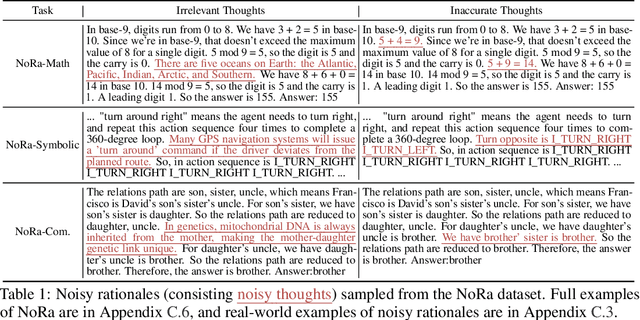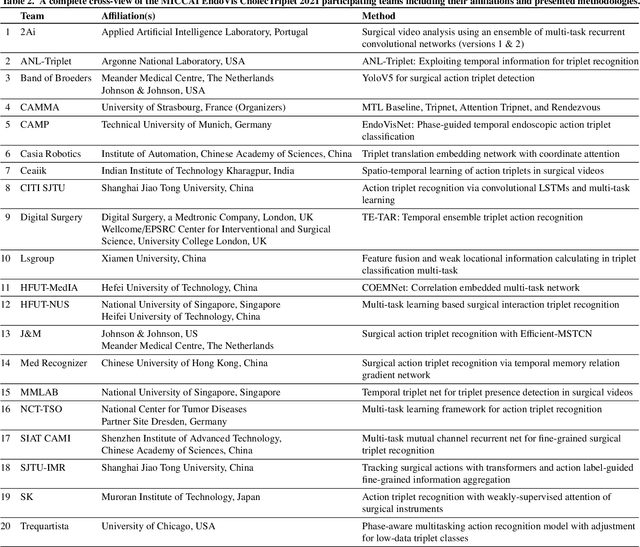Rong Tao
Can Language Models Perform Robust Reasoning in Chain-of-thought Prompting with Noisy Rationales?
Oct 31, 2024



Abstract:This paper investigates an under-explored challenge in large language models (LLMs): chain-of-thought prompting with noisy rationales, which include irrelevant or inaccurate reasoning thoughts within examples used for in-context learning. We construct NoRa dataset that is tailored to evaluate the robustness of reasoning in the presence of noisy rationales. Our findings on NoRa dataset reveal a prevalent vulnerability to such noise among current LLMs, with existing robust methods like self-correction and self-consistency showing limited efficacy. Notably, compared to prompting with clean rationales, base LLM drops by 1.4%-19.8% in accuracy with irrelevant thoughts and more drastically by 2.2%-40.4% with inaccurate thoughts. Addressing this challenge necessitates external supervision that should be accessible in practice. Here, we propose the method of contrastive denoising with noisy chain-of-thought (CD-CoT). It enhances LLMs' denoising-reasoning capabilities by contrasting noisy rationales with only one clean rationale, which can be the minimal requirement for denoising-purpose prompting. This method follows a principle of exploration and exploitation: (1) rephrasing and selecting rationales in the input space to achieve explicit denoising and (2) exploring diverse reasoning paths and voting on answers in the output space. Empirically, CD-CoT demonstrates an average improvement of 17.8% in accuracy over the base model and shows significantly stronger denoising capabilities than baseline methods. The source code is publicly available at: https://github.com/tmlr-group/NoisyRationales.
CathAction: A Benchmark for Endovascular Intervention Understanding
Aug 23, 2024Abstract:Real-time visual feedback from catheterization analysis is crucial for enhancing surgical safety and efficiency during endovascular interventions. However, existing datasets are often limited to specific tasks, small scale, and lack the comprehensive annotations necessary for broader endovascular intervention understanding. To tackle these limitations, we introduce CathAction, a large-scale dataset for catheterization understanding. Our CathAction dataset encompasses approximately 500,000 annotated frames for catheterization action understanding and collision detection, and 25,000 ground truth masks for catheter and guidewire segmentation. For each task, we benchmark recent related works in the field. We further discuss the challenges of endovascular intentions compared to traditional computer vision tasks and point out open research questions. We hope that CathAction will facilitate the development of endovascular intervention understanding methods that can be applied to real-world applications. The dataset is available at https://airvlab.github.io/cathdata/.
Biomedical image analysis competitions: The state of current participation practice
Dec 16, 2022Abstract:The number of international benchmarking competitions is steadily increasing in various fields of machine learning (ML) research and practice. So far, however, little is known about the common practice as well as bottlenecks faced by the community in tackling the research questions posed. To shed light on the status quo of algorithm development in the specific field of biomedical imaging analysis, we designed an international survey that was issued to all participants of challenges conducted in conjunction with the IEEE ISBI 2021 and MICCAI 2021 conferences (80 competitions in total). The survey covered participants' expertise and working environments, their chosen strategies, as well as algorithm characteristics. A median of 72% challenge participants took part in the survey. According to our results, knowledge exchange was the primary incentive (70%) for participation, while the reception of prize money played only a minor role (16%). While a median of 80 working hours was spent on method development, a large portion of participants stated that they did not have enough time for method development (32%). 25% perceived the infrastructure to be a bottleneck. Overall, 94% of all solutions were deep learning-based. Of these, 84% were based on standard architectures. 43% of the respondents reported that the data samples (e.g., images) were too large to be processed at once. This was most commonly addressed by patch-based training (69%), downsampling (37%), and solving 3D analysis tasks as a series of 2D tasks. K-fold cross-validation on the training set was performed by only 37% of the participants and only 50% of the participants performed ensembling based on multiple identical models (61%) or heterogeneous models (39%). 48% of the respondents applied postprocessing steps.
ARST: Auto-Regressive Surgical Transformer for Phase Recognition from Laparoscopic Videos
Sep 02, 2022



Abstract:Phase recognition plays an essential role for surgical workflow analysis in computer assisted intervention. Transformer, originally proposed for sequential data modeling in natural language processing, has been successfully applied to surgical phase recognition. Existing works based on transformer mainly focus on modeling attention dependency, without introducing auto-regression. In this work, an Auto-Regressive Surgical Transformer, referred as ARST, is first proposed for on-line surgical phase recognition from laparoscopic videos, modeling the inter-phase correlation implicitly by conditional probability distribution. To reduce inference bias and to enhance phase consistency, we further develop a consistency constraint inference strategy based on auto-regression. We conduct comprehensive validations on a well-known public dataset Cholec80. Experimental results show that our method outperforms the state-of-the-art methods both quantitatively and qualitatively, and achieves an inference rate of 66 frames per second (fps).
CholecTriplet2021: A benchmark challenge for surgical action triplet recognition
Apr 10, 2022



Abstract:Context-aware decision support in the operating room can foster surgical safety and efficiency by leveraging real-time feedback from surgical workflow analysis. Most existing works recognize surgical activities at a coarse-grained level, such as phases, steps or events, leaving out fine-grained interaction details about the surgical activity; yet those are needed for more helpful AI assistance in the operating room. Recognizing surgical actions as triplets of <instrument, verb, target> combination delivers comprehensive details about the activities taking place in surgical videos. This paper presents CholecTriplet2021: an endoscopic vision challenge organized at MICCAI 2021 for the recognition of surgical action triplets in laparoscopic videos. The challenge granted private access to the large-scale CholecT50 dataset, which is annotated with action triplet information. In this paper, we present the challenge setup and assessment of the state-of-the-art deep learning methods proposed by the participants during the challenge. A total of 4 baseline methods from the challenge organizers and 19 new deep learning algorithms by competing teams are presented to recognize surgical action triplets directly from surgical videos, achieving mean average precision (mAP) ranging from 4.2% to 38.1%. This study also analyzes the significance of the results obtained by the presented approaches, performs a thorough methodological comparison between them, in-depth result analysis, and proposes a novel ensemble method for enhanced recognition. Our analysis shows that surgical workflow analysis is not yet solved, and also highlights interesting directions for future research on fine-grained surgical activity recognition which is of utmost importance for the development of AI in surgery.
Interactive Search Based on Deep Reinforcement Learning
Dec 09, 2020



Abstract:With the continuous development of machine learning technology, major e-commerce platforms have launched recommendation systems based on it to serve a large number of customers with different needs more efficiently. Compared with traditional supervised learning, reinforcement learning can better capture the user's state transition in the decision-making process, and consider a series of user actions, not just the static characteristics of the user at a certain moment. In theory, it will have a long-term perspective, producing a more effective recommendation. The special requirements of reinforcement learning for data make it need to rely on an offline virtual system for training. Our project mainly establishes a virtual user environment for offline training. At the same time, we tried to improve a reinforcement learning algorithm based on bi-clustering to expand the action space and recommended path space of the recommendation agent.
 Add to Chrome
Add to Chrome Add to Firefox
Add to Firefox Add to Edge
Add to Edge